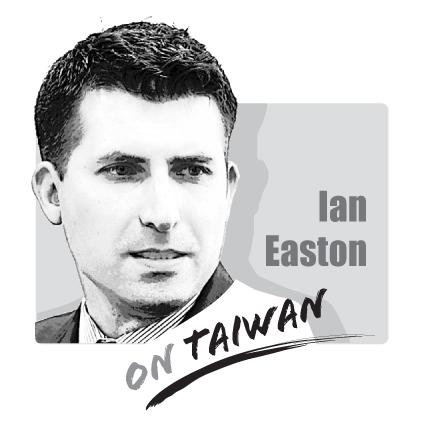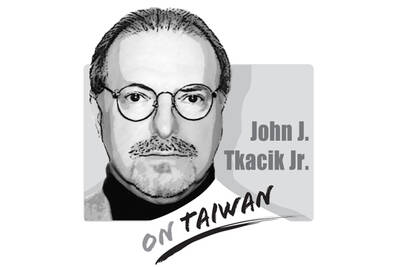The United States and the Republic of China (ROC, Taiwan) have yet to resolve fundamental differences of opinion when it comes to defense strategy. To be sure, the two sides have always had somewhat opposing views. That is only natural. Taiwan is a middleweight regional power, located at the doorstep of the People’s Republic of China (PRC, China). America is a massive global superpower, located outside the immediate potential warzone.
Neither side understands the other as well as you might expect from countries with close ties and decades of defense and security cooperation. Many observers hoped that the election of President Donald Trump would help close the gap, especially after his December 2016 phone call with President Tsai Ing-wen (蔡英文). It now appears that the Trump administration could be too distracted to make game-changing moves.
A few modest exceptions aside, Washington’s main talking points on Taiwan defense issues are the same as those heard during the Obama years. US government officials continue to call on the Taiwanese to spend more on defense. They tell Taipei to focus on rapidly building up “asymmetric and innovative” (read: affordable and inoffensive) capabilities that could, in theory, make it an unappealing target of invasion. This has real merit. But some official views are heavily influenced by something referred to as the “porcupine strategy,” an odd concept that appeared in the latter half of the George W. Bush administration and grew in influence during the Obama years. It rests upon the assumption that a passive Taiwanese defense posture would be advantageous.

The argument goes something like this: Taiwan should forgo all investments into major military combatants like submarines, fighter jets, tanks, ballistic missile defenses, and cruise missiles. Instead, Taiwanese generals should focus on defending their territory with small, mobile, short-range weapons that could be deployed at low cost and in great numbers. Taiwan does not have time on its side. China could invade soon, and so the island should forget about ever plugging into a broader US regional defense network with compatible operating systems. That would be expensive and could take a long time to come online.
Porcupine fans seem to assume that, for Taiwan, the main effort should be preparing to fight on the beaches and across the densely populated home island, not along the PRC coast, on Taiwan’s outer islands, or in the air and on the sea. Taiwan’s ability to expand the battle space and conduct counterstrikes on targets deep in China would violate delicate US State Department sensibilities. With varying degrees of intensity, Washington has long opposed Taiwan’s development of nuclear weapons, ballistic missiles, cruise missiles, and armed drones.
A few American officials still continue to argue that it would be better if Taiwanese defense authorities did little other than hone the ability to hold out when attacked. In their view, “offensive” operations should be left to US forces that may (or may not) be ordered to rescue the island from an overwhelming Chinese assault. They argue that Taiwan should assume it will lose an effective air force and navy in the first days of war, and possibly even within hours of the onset of enemy attack. It is unknowable in peacetime whether such dire estimates would prove correct. They certainly might. But they also might not.
In contrast, Taiwanese officials often emphasize the need to take the fight to the enemy. They argue that Taiwan’s armed forces must prepare to defend against a wide range of possible Chinese actions. The near-term doomsday scenario is not the only one out there.
For reasons of military feasibility and political prudence, national security authorities in Taiwan are reluctant to shred long-worked war plans and retire serving hardware in favor of experimental concepts and systems like unmanned mini-subs. They prefer tried and tested defense capabilities and standard methods of strategic competition.
While positive parts of the US government-approved defense strategy for Taiwan appear to have been incorporated into Taiwan’s Overall Defense Concept, Taipei hedges its bets by continuing investments into major platforms. Taiwanese leaders clearly cherish the hope that their country could one day join a broader American-led regional defense network with compatible operating systems. This future option remains open, but uncertain. At the same time, they also know that Taiwan must strengthen its local indigenous defense industry to maintain its freedom of action in the face of the ever-present question marks that surround Washington’s dedication and commitment.
American leaders, beset by a seemingly endless series of international and domestic crises, have long ignored the main strategic issue: the predatory ascendance of China. The dysfunctional diplomatic relationship between Washington and Taipei (unofficial relations are inherently abnormal), and significant Chinese Communist Party influence activities in the United States, further ensure that Taiwan is not treated like an important player. As a country that is not treated as a country, Taiwan gets taken for granted. Its voice gets lost and its ability to contribute to a greater cause restricted.
The room for improvement is vast. It makes sense for the US and Taiwan to do more to ensure their own respective national security interests, even when this can mean doing things that could complicate relations with the regime in Beijing. As the long-term strategic competition between the free world and China unfolds, it will probably become increasingly important that Taiwan is able to offer the Indo-Pacific region a balanced suite of military capabilities far sharper than those currently envisioned by many in Washington.
The good news is that the great defense debate has not embittered either side.
Military professionals in America and Taiwan have a huge advantage over their Chinese adversaries: They come from open societies where hard questions are encouraged and intellectual jousts are warmly welcomed. Both sides continue to regard each other with sincere goodwill. Thousands of exchanges are now occurring every year between the Pentagon and the Ministry of National Defense, and work is progressing in the spirit of friendship.
The US and Taiwan must do far more to keep Chairman Xi Jinping (習近平) from breaking the peace. It is essential they develop a joint defense work plan and become a unified team.
Efforts are needed on both sides to forge a smart path forward. Discussions and debates can and should continue. But action is needed before the strategic scene becomes unhinged.
Ian Easton is a research fellow at the Project 2049 Institute and author of The Chinese Invasion Threat: Taiwan’s Defense and American Strategy in Asia (中共攻台大解密).

“Si ambulat loquitur tetrissitatque sicut anas, anas est” is, in customary international law, the three-part test of anatine ambulation, articulation and tetrissitation. And it is essential to Taiwan’s existence. Apocryphally, it can be traced as far back as Suetonius (蘇埃托尼烏斯) in late first-century Rome. Alas, Suetonius was only talking about ducks (anas). But this self-evident principle was codified as a four-part test at the Montevideo Convention in 1934, to which the United States is a party. Article One: “The state as a person of international law should possess the following qualifications: a) a permanent population; b) a defined territory; c) government;
The central bank and the US Department of the Treasury on Friday issued a joint statement that both sides agreed to avoid currency manipulation and the use of exchange rates to gain a competitive advantage, and would only intervene in foreign-exchange markets to combat excess volatility and disorderly movements. The central bank also agreed to disclose its foreign-exchange intervention amounts quarterly rather than every six months, starting from next month. It emphasized that the joint statement is unrelated to tariff negotiations between Taipei and Washington, and that the US never requested the appreciation of the New Taiwan dollar during the
Since leaving office last year, former president Tsai Ing-wen (蔡英文) has been journeying across continents. Her ability to connect with international audiences and foster goodwill toward her country continues to enhance understanding of Taiwan. It is possible because she can now walk through doors in Europe that are closed to President William Lai (賴清德). Tsai last week gave a speech at the Berlin Freedom Conference, where, standing in front of civil society leaders, human rights advocates and political and business figures, she highlighted Taiwan’s indispensable global role and shared its experience as a model for democratic resilience against cognitive warfare and
The diplomatic spat between China and Japan over comments Japanese Prime Minister Sanae Takaichi made on Nov. 7 continues to worsen. Beijing is angry about Takaichi’s remarks that military force used against Taiwan by the Chinese People’s Liberation Army (PLA) could constitute a “survival-threatening situation” necessitating the involvement of the Japanese Self-Defense Forces. Rather than trying to reduce tensions, Beijing is looking to leverage the situation to its advantage in action and rhetoric. On Saturday last week, four armed China Coast Guard vessels sailed around the Japanese-controlled Diaoyutai Islands (釣魚台), known to Japan as the Senkakus. On Friday, in what